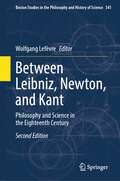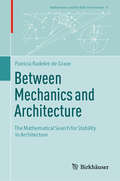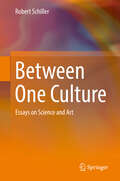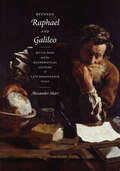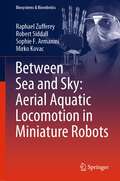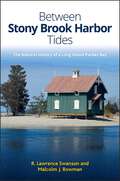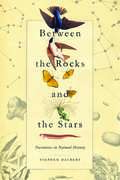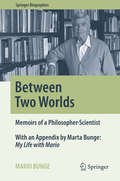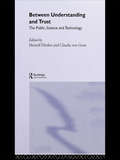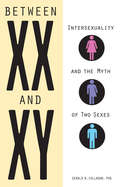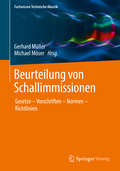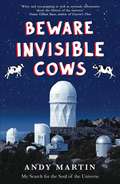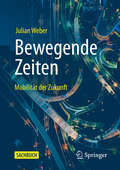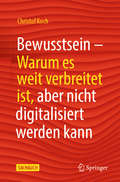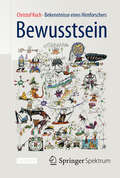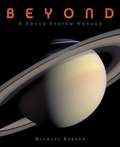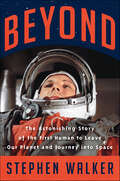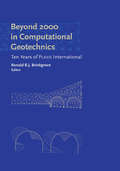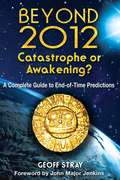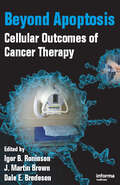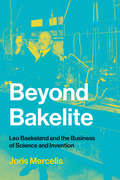- Table View
- List View
Between Leibniz, Newton, and Kant: Philosophy and Science in the Eighteenth Century (Boston Studies in the Philosophy and History of Science #341)
by Wolfgang LefèvreThis addresses the transformations of metaphysics as a discipline, the emergence of analytical mechanics, the diverging avenues of 18th-century Newtonianism, the body-mind problem, and philosophical principles of classification in the life sciences. An appendix contains a critical edition and first translation into English of Newton's scholia from David Gregory's Estate on the Propositions IV through IX Book III of his Principia.
Between Mechanics and Architecture: The Mathematical Search for Stability in Architecture (Mathematics and the Built Environment #8)
by Patricia Radelet-de GraveThis collection of essays reflects the author's decades-long dedication to studying the interplay between mechanics and architecture. It explores how advancements in mechanics have influenced architectural innovation and how the need for new architectural solutions has driven theoretical progress in engineering. By examining the historical roots of these fields, these essays provide a deep analysis of key developments. This interdisciplinary work will appeal to scholars, students, and anyone interested in the complex relationship between the theoretical and practical aspects of architecture and civil engineering.
Between One Culture: Essays on Science and Art
by Robert SchillerThis book argues that science and the arts are not two different cultures, but rather different manifestations of the same culture. Divided into seven parts, it presents a collection of translated and revised essays, mostly at the intersection between realia and humaniora. In the first two parts, the author discusses how some myths, both ancient and modern, have become intertwined with scientific ideas. The chapters in the following four parts address poems, novels, plays, and pieces of fine art that have some scientific content, as well as scientific findings which seem to have also been discovered in art. The chapters in the final part examine a number of inspiring doubts and necessary errors in the history of science. This collection of essays, most of which were originally published in Hungarian, is intended for the general public and as such includes no mathematical, physical or chemical formulae. It offers a unique resource for all those curious about the interconnections between science, art and literature.
Between Raphael and Galileo: Mutio Oddi and the Mathematical Culture of Late Renaissance Italy
by Alexander MarrAlthough largely unknown today, during his lifetime Mutio Oddi of Urbino (1569–1639) was a highly esteemed scholar, teacher, and practitioner of a wide range of disciplines related to mathematics. A prime example of the artisan-scholar so prevalent in the late Renaissance, Oddi was also accomplished in the fields of civil and military architecture and the design and retail of mathematical instruments, as well as writing and publishing. In Between Raphael and Galileo, Alexander Marr resurrects the career and achievements of Oddi in order to examine the ways in which mathematics, material culture, and the book shaped knowledge, society, and the visual arts in late Renaissance Italy. Marr scrutinizes the extensive archive of Oddi papers, documenting Oddi’s collaboration with prominent intellectuals and officials and shedding new light on the practice of science and art during his day. What becomes clear is that Oddi, precisely because he was not spectacularly innovative and did not attain the status of a hero in modern science, is characteristic of the majority of scientific practitioners and educators active in this formative age, particularly those whose energetic popularization of mathematics laid the foundations for the Scientific Revolution. Marr also demonstrates that scientific change in this era was multivalent and contested, governed as much by friendship as by principle and determined as much by places as by purpose.Plunging the reader into Oddi’s world, Between Raphael and Galileo is a finely wrought and meticulously researched tale of science, art, commerce, and society in the late sixteenth and early seventeenth century. It will become required reading for any scholar interested in the history of science, visual art, and print culture of the Early Modern period.
Between Sea and Sky: Aerial Aquatic Locomotion in Miniature Robots (Biosystems & Biorobotics #29)
by Raphael Zufferey Robert Siddall Sophie F. Armanini Mirko KovacThis book reports on the state of the art in the field of aerial-aquatic locomotion, focusing on the main challenges concerning the translation of this important ability from nature to synthetic systems, and describing innovative engineering solutions that have been applied in practice by the authors at the Aerial Robotics Lab of Imperial College London. After a general introduction to aerial-aquatic locomotion in nature, and a summary of the most important engineering achievements, the book introduces readers to important physical and mathematical aspects of the multimodal locomotion problem. Besides the basic physics involved in aerial-aquatic locomotion, the role of different phenomena happening in fluids, or those due to structural mechanics effects or to power provision, are presented in depth, across a large dimension range, from millimeters to hundreds of meters. In turn, a practice-oriented discussion on the obstacles and opportunities of miniaturization, for both robots and animals is carried out. This is followed by applied engineering considerations, which describe relevant hardware considerations involved in propulsion, control, communication and fabrication. Different case studies are analyzed in detail, reporting on the latest research carried out by the authors, and covering topics such as propulsive aquatic escape, the challenging mechanics of water impact, and a hybrid sailing and flying aircraft. Offering extensive and timely information on the design, construction and operation of small-scale robots, and on multimodal locomotion, this book provides researchers, students and professionals with a comprehensive and timely reference guide to the topic of aerial-aquatic locomotion, and the relevant bioinspired approaches. It is also expected to inspire future research and foster a stronger multidisciplinary discussion in the field.
Between Stony Brook Harbor Tides: The Natural History of a Long Island Pocket Bay (Excelsior Editions)
by R. Lawrence Swanson Malcolm J. BowmanWinner of the 2017 Robert Cushman Memorial Award presented by the Three Village Historical SocietyStony Brook Harbor, or Three Sisters Harbor as it was known historically, is perhaps the most pristine of the Long Island north shore pocket bays. Untouched by major commercialization, it has been designated a Significant Coastal Fish and Wildlife Habitat by the New York State Department of State and a Significant Coastal Habitat by the US Fish and Wildlife Service. Despite these designations, however, there is constant pressure to increase development of and around the harbor.Between Stony Brook Harbor Tides interweaves scientific understandings of the harbor with a consideration of its colorful history to inform and educate a general audience about its unique and delicate state. Data is used to illustrate the harbor's tides and currents and to show how they influence geological processes and pollution susceptibility. Storm surge measurements going back to the early 1990s document some of the extreme high waters experienced, and descriptions of some of the more interesting or important marine species of plants and animals found in the harbor are also included. The book discusses the century-long conflicts that local residents have fought in order to preserve this beautiful place, and it documents the tools that currently exist to help manage the harbor well into the twenty-first century. An excellent supplement to any high school or undergraduate environmental course, Between Stony Brook Harbor Tides provides readers with a basis for embracing the significance of the harbor and what it can bring to future residents.
Between the Rocks and the Stars: Narratives in Natural History
by Stephen DaubertThese stories take readers where they cannot go, be it out into space, back in time, deep under the ocean, down to micro-scopic scales, or out onto the geologic overview. Squid turn themselves inside-out when disturbed by predators hunting through the darkness with sonar. Beneficial microbes spend their summer living in nectar and being transferred between blooms by the bees, then spend the winter living within those bees. Ecological stories are seen through the eyes of squirrels, birds, fish, ants, butterflies, and beetles.Between the Rocks and the Stars dives deep into the relationships that shape the natural world. The book presents a collection of vignettes from the wild, each of which describes the natural advantage of a particular organism. These true-to-life accounts are then posed in particular circumstances that illustrate the principles—commensalism, speciation—that shape the place of these organisms in their living environment. Some stories cover topics in geology and cosmology, describing the physical world context in which natural history progresses across the eons. Underlying themes in the book include the network of connections that link all these organisms together and the adaptations they make to the physical world in which they must find themselves a home.
Between the Rocks and the Stars: Narratives in Natural History
by Stephen DaubertThese stories take readers where they cannot go, be it out into space, back in time, deep under the ocean, down to microscopic scales, or out onto the geologic overview. Squid turn themselves inside-out when disturbed by predators hunting through the darkness with sonar. Beneficial microbes spend their summer living in nectar and being transferred between blooms by the bees, then spend the winter living within those bees. Ecological stories are seen through the eyes of squirrels, birds, fish, ants, butterflies, and beetles.Between the Rocks and the Stars dives deep into the relationships that shape the natural world. The book presents a collection of vignettes from the wild, each of which describes the natural advantage of a particular organism. These true-to-life accounts are then posed in particular circumstances that illustrate the principles—commensalism, speciation—that shape the place of these organisms in their living environment. Some stories cover topics in geology and cosmology, describing the physical world context in which natural history progresses across the eons. Underlying themes in the book include the network of connections that link all these organisms together and the adaptations they make to the physical world in which they must find themselves a home.
Between Two Worlds: Memoirs of a Philosopher-Scientist (Springer Biographies)
by Mario BungeTo go through the pages of the Autobiography of Mario Bunge is to accompany him through dozens of countries and examine the intellectual, political, philosophical and scientific spheres of the last hundred years. It is an experience that oscillates between two different worlds: the different and the similar, the professional and the personal. It is an established fact that one of his great loves was, and still is, science. He has always been dedicated to scientific work, teaching, research, and training men and women in multiple disciplines. Life lessons fall like ripe fruit from this book, bringing us closer to a concept, a philosophical idea, a scientific digression, which had since been uncovered in numerous notes, articles or books. Bunge writes about the life experiences in this book with passion, naturalness and with a colloquial frankness, whether they be persecutions, banishment, imprisonment, successes, would-be losses, emotions, relationships, debates, impressions or opinions about people or things. In his pages we pass by the people with whom he shared a fruitful century of achievements and incredible depths of thought. Everything is remembered with sincerity and humor. This autobiography is, in truth, Bunge on Bunge, sharing everything that passes through the sieve of his memory, as he would say. Mario's many grandchildren are a testament to his proud standing as a family man, and at the age of 96 he gives us a book for everyone: for those who value the memories that hold the trauma of his life as well as for those who share his passion for science and culture. Also, perhaps, for some with whom he has had disagreements or controversy, for he still deserves recognition for being a staunch defender of his convictions.
Between Understanding and Trust: The Public, Science and Technology
by Meinolf Dierkes Claudia Von Grote'This is a welcome book. The issues of public understanding of science open many questions. What does "understanding" mean? How does understanding translate into attitudes towards science and trust in scientists? What is the role of the mass media? The essays in this book shed light on such questions bringing insights from several disciplines. They help to define a meaningful research agenda for the future. - Professor Dorothy Nelkin, New York University
Between XX and XY: Intersexuality and the Myth of Two Sexes
by Gerald CallahanProviding a fascinating look at the science of sex and what makes people male or female, this book explains dozens of intersex conditions--such as hermaphroditism, Klinefelter syndrome, and androgen insensitivity syndrome--and includes personal interviews with people living with these conditions telling their surprising and often heart-wrenching stories. Even doctors and scientists are not entirely sure if external genitalia, internal sex organs, chromosomes, DNA, environment, or some combination define a person's sex, but this examination shows that sex is not an either-or proposition: not girl/boy, XX/XY--there are babies born XYY, XXX, or with any dozen or more known variations in the X or Y chromosomes. The history and the current treatment for intersex conditions as well as the options that are available today for the ambiguous child are covered in this captivating account that truly shows what it means to be human.
Beurteilung von Schallimmissionen: Gesetze – Vorschriften – Normen – Richtlinien (Fachwissen Technische Akustik)
by Michael Möser Gerhard MüllerDieser Band der Reihe Fachwissen Technische Akustik beschreibt das Ausmaß von Lärmwirkungen mit Hilfe objektivierbarer Einflussfaktoren. Die behandelten Themen dienen dazu, Aussagen zu treffen, ob angestrebte Schutzziele, wie z.B. die Vermeidung erheblicher Belästigungen oder die Gewährleistung einer guten Sprachverständlichkeit, erreicht werden.
Beware Invisible Cows
by Andy MartinWhat really happened at the moment of the Big Bang? And how the hell do we know? And why is finding out so important? And who are these people who design and build these experiments? And is it all worth it? Andy Martin sets out on a road trip to search for the soul of the universe. In his personal quest for the mother of all truths, he has to go all the way back to the origin of time and space. He climbs up to the highest observatory in the world and sticks his head inside a 4 km-long laser tube capable of surfing waves from the Big Bang. He sees himself the way he used to be in a mirror and he discovers where you go when you die. He has close encounters with aliens and intimations of immortality. This book has everything -- science, philosophy, literature, religion, Einstein, Weinstein, God, the Godfather, all seen through a glass darkly.
Bewegende Zeiten: Mobilität der Zukunft
by Julian WeberSitzen wir wirklich schon bald nicht mehr selbst am Steuer unseres Autos, sondern werden nur noch von fahrerlosen Elektro-Taxis ans Ziel gebracht? Sollen Städte Car Sharing einführen? Welche Rolle werden Elektroroller, Seilbahnen oder manntragende Drohnen in den Mobilitätssystemen der Großstädte spielen? Dieses Buch erklärt endlich allgemeinverständlich, was sich hinter Schlagworten wie Elektromobilität, autonomes Fahren, Digitalisierung und Mobilitätsdienstleistungen wie Car Sharing oder Ride Hailing wirklich verbirgt, wie weit fortgeschritten diese Technologien heute sind, und vor allem auch in welchen Beziehungen und Abhängigkeiten diese zueinander stehen. Dabei werden neben den technischen auch die gesetzgeberischen und gesellschaftlichen Trends betrachtet, die als wichtige Rahmenbedingungen die Mobilität der Zukunft maßgeblich mitbestimmen.Aus dem Inhalt• Mobilitätsbedarfe: Wer will alles wann, warum wohin – und wie wird sich das in Zukunft ändern?• Technologische Trends: Elektromobilität, Digitalisierung, Autonomes Fahren – was werden die Fahrzeuge der Zukunft können?• Car Sharing, Ride Hailing, E-Scooter oder doch öffentlicher Nahverkehr: Welche Alternativen zum eigenen Pkw wird es in Zukunft geben?• Politik und Gesellschaft: Wie werden sich die Rahmenbedingungen der Mobilität in Zukunft entwickeln?• Mobilität im Wandel: Was sollten wir tun, um uns auf die Zukunft vorzubereiten?
Bewusst oder unbewusst? (Erlebnis Wissenschaft)
by Heinz Georg SchusterWhat is consciousness? This is the main question asked by the author, Prof Schuster, a specialist in complex adaptive systems and evolution models. From a natural scientific viewpoint he seeks answers to such questions as: How does this process work? How is our consciousness functionally organized as an evolutionary control process? And what is the difference between us and animals? Based on the hypothesis that human consciousness mainly has large evolutionary benefits in social behavior, this book investigates in a fascinating way the anatomical fundamentals, the development of conscious thought in the course of evolution, the creation of the self-image, empathy and language. Further, the possible dangers of artificial consciousness are discussed, a threat posed, for example, by even more intelligent computers.
Bewusstsein: Warum es weit verbreitet ist, aber nicht digitalisiert werden kann
by Christof KochBewusstsein – das weiter verbreitet ist als bisher angenommen – ist das Gefühl, lebendig zu sein, es ist kein Rechenvorgang und auch kein cleverer Trick. In diesem Buch liefert Christof Koch eine schnörkellose Definition des Bewusstseins als bewusstes Erleben, vom alltäglichsten bis zum außergewöhnlichsten – eben das Gefühl zu leben.Die Psychologie erforscht, welche kognitiven Vorgänge einer bewussten Wahrnehmung jeweils zugrunde liegen. Die Neurowissenschaft spürt den neuronalen Korrelaten des Bewusstseins im Gehirn nach, dem Organ des Geistes. Aber warum das Gehirn und nicht etwa die Leber oder ein anderes Organ? Wie kann das Gehirn, drei Pfund höchst erregbares Gewebe, ein Gegenstand im Universum, der denselben physikalischen Gesetzen gehorcht wie jeder andere Gegenstand, subjektives Erleben hervorbringen? Will man eine Antwort auf diese Frage finden, braucht man, so Koch, eine quantitative Theorie, die beim Erleben ansetzt und zum Gehirn fortschreitet. Im vorliegenden Buch umreißt der Autor eine solche Theorie, basierend auf der integrierten Informationstheorie. Koch beschreibt, wie die Theorie viele Fakten zur Neurologie des Bewusstseins erklärt und wie man mit ihrer Hilfe sogar ein in der Klinik einsetzbares Bewusstseins-Messgerät konstruiert hat. Die Theorie sagt voraus, dass viele, ja vielleicht alle Tiere das Leben in vielen Facetten erleben; Bewusstsein ist viel weiter verbreitet als allgemein angenommen. Entgegen der landläufigen Ansicht aber argumentiert Koch, dass programmierbare Computer kein Bewusstsein haben werden. Selbst ein perfektes Softwaremodell des Gehirns ist nicht bewusst – es simuliert lediglich Bewusstsein. Bewusstsein ist keine bestimmte Art von Rechenvorgang, es ist kein cleverer Trick. Bewusstsein ist Sein.reich mit dem Sachbuchprogramm waren.
Bewusstsein: Bekenntnisse eines Hirnforschers
by Christof Koch Jorunn Wissmann Monika Niehaus-OsterlohWie kann Aktivität im Gehirn Gefühle auslösen? Wie kann "bloßes Fleisch" - so wird der Körper in Cyberpunkromanen oft abfällig genannt -- subjektives Empfinden hervorbringen? Oder allgemeiner gesagt: Wie kann etwas Physisches etwas Nichtphysisches, subjektive Zustände erzeugen? Ob es der Zahnschmerz ist, die Freude beim Anblick der eigenen Kinder oder der Geschmack eines edlen Weins, sie alle haben denselben Ursprung in der Aktivität von Nervengewebe, im Bewusstsein. Christof Koch forscht seit Jahren über das Thema Bewusstsein. In einer Art Bestandsaufnahme zeigt er den derzeitigen Stand der Forschung auf, an dem auch maßgeblich Wissenschaftler wie Francis Crick, Ned Block, David Chalmers, Stanislas Dehaene, Giulio Tononi und Wolf Singer mitgewirkt haben. Ihm erscheint nicht als Widerspruch, mit naturwissenschaftlichen, empirischen Methoden erklären zu wollen, wie Gefühle entstehen. Wir sind uns der meisten Dinge, die in unserem Kopf vorgehen, nicht bewusst. Koch postuliert, dass Zombies ohne Bewusstsein in weiten Teilen unser Leben steuern, auch wenn wir der festen Überzeugung sind, darüber selbst zu bestimmen. Seiner Meinung nach wird es gelingen, empfindungsfähige Maschinen zu bauen - er liefert eine erste Vorlage hierfür im Buch. Er reflektiert so diverse Aspekte wie die Unterscheidung zwischen Aufmerksamkeit und Bewusstsein, das Unbewusste, die Physik und Biologie des freien Willen, Hunde, den Ring der Nibelungen, den Glauben an einen persönlichen Gott und Traurigkeit. Kochs Buch ist mehr als ein wissenschaftlicher Überblick - es ist zudem Bekenntnis, Autobiographie und futuristische Spekulation.
Bewusstsein und optimierter Wille
by Helmut PfütznerDas Fehlen freien Willens - so die Sorge der Dualisten - entwürdigt den Menschen. Der Text belegt das Gegenteil: das Fehlen macht den Menschen robust und verlässlich. Dazu entwirft das Buch ein auf schrittweise optimierenden Vorgängen basierendes biophysikalisches Iterations-Modell, das die elementaren Funktionen des Gehirns in konsequenter Weise interpretiert. Aus nüchterner Sicht der Biophysik ist es hohe Konzentration von spezifischen Neuronen, die das höchst physische Phänomen des Bewusstseins entstehen lässt. Voraussetzung dafür ist, dass "Vehemenz" des Denkens aufkommt. Bewusstsein ist kein Produkt der Evolution, sondern ein den Naturgesetzen a priori zugegebener Faktor. Der ist zwar beschreibbar, doch nicht erklärbar - ebenso wenig wie Magnetismus oder Gravitation. An die Stelle von ,,freiem" Willen rückt ,,optimierter" Wille: Das von Ererbtem und Erworbenem geprägte Ich bestimmt das Handeln und Denken in optimierter Weise, gemeinsam mit Einflüssen der Umwelt. p>
Beyond: A Solar System Voyage
by Michael BensonDiscover what the solar system looks like up close in this definitive collection of space exploration images. Since the 1960s, NASA has been sending unmanned satellites to explore the planets, moons, and sun. These probes have amassed a stunning visual record of other worlds, revealing not one but scores of new frontiers, from rust-red Mars to Saturn with its ethereal rings. Michael Benson has pulled together the most spectacular of these images into a volume that focuses on the awesome appearance of these celestial bodies. He discusses what the photos actually reveal about the places in simple language children will understand. The book includes a glossary, a bibliography, and an index. "Dramatic, unframed color photos on thick glossy paper...the science details are just as exciting as the pictures. Starting with a long chapter on the early history of astronomy, Benson examines the Solar System from the perspectives of robot explorers launched in the last 60 years. He also gives in-depth descriptions of how the photos were taken by unmanned spacecraft...The informal text raises the big questions that will captivate young readers: Are we alone in the universe? Has Mars ever supported life? Does life exist there now? Or elsewhere? More than 20 space probes are in action right now, and engaged readers will want to reference the listed Web sites. The comprehensive glossary is also a handy resource. "--Booklist "A mesmerizing grand tour of solar-system high spots. Gathered with the premise that they are significant achievements in the history of not just science, but photography as well, these big, sharply detailed images were all taken by (specifically) space probes and were chosen for their visual impact...the photos range from a primitive 1967 composite shot of the Moon to haunting close-up views of mysterious Neptune and its moon Triton taken by Voyager 2 in 1989...our nearest neighbors in space have never looked better. "--Kirkus Reviews F&P level: Z F&P genre: I
Beyond: Our Future in Space
by Chris ImpeyBeyond dares to imagine a fantastic future for humans in space--and then reminds us that we're already there. Human exploration has been an unceasing engine of technological progress, from the first homo sapiens to leave our African cradle to a future in which mankind promises to settle another world. Beyond tells the epic story of humanity leaving home--and how humans will soon thrive in the vast universe beyond the earth. A dazzling and propulsive voyage through space and time, Beyond reveals how centuries of space explorers--from the earliest stargazers to today's cutting-edge researchers--all draw inspiration from an innate human emotion: wanderlust. This urge to explore led us to multiply around the globe, and it can be traced in our DNA. Today, the urge to discover manifests itself in jaw-dropping ways: plans for space elevators poised to replace rockets at a fraction of the cost; experiments in suspending and reanimating life for ultra-long-distance travel; prototypes for solar sails that coast through space on the momentum of microwaves released from the Earth. With these ventures, private companies and entrepreneurs have the potential to outpace NASA as the leaders in a new space race. Combining expert knowledge of astronomy and avant-garde technology, Chris Impey guides us through the heady possibilities for the next century of exploration. In twenty years, a vibrant commercial space industry will be operating. In thirty years, there will be small but viable colonies on the Moon and Mars. In fifty years, mining technology will have advanced enough to harvest resources from asteroids. In a hundred years, a cohort of humans born off-Earth will come of age without ever visiting humanity's home planet. This is not the stuff of science fiction but rather the logical extension of already available technologies. Beyond shows that space exploration is not just the domain of technocrats, but the birthright of everyone and the destiny of generations to come. To continue exploration is to ensure our survival. Outer space, a limitless unknown, awaits us.
Beyond: The Astonishing Story of the First Human to Leave Our Planet and Journey into Space
by Stephen Walker09.07 am. April 12, 1961. A top secret rocket site in the USSR. A young Russian sits inside a tiny capsule on top of the Soviet Union’s most powerful intercontinental ballistic missile—originally designed to carry a nuclear warhead—and blasts into the skies. His name is Yuri Gagarin. And he is about to make history. <p><p> Travelling at almost 18,000 miles per hour—ten times faster than a rifle bullet—Gagarin circles the globe in just 106 minutes. From his windows he sees the earth as nobody has before, crossing a sunset and a sunrise, crossing oceans and continents, witnessing its beauty and its fragility. While his launch begins in total secrecy, within hours of his landing he has become a world celebrity – the first human to leave the planet. <p><p> Beyond tells the thrilling story behind that epic flight on its 60th anniversary. It happened at the height of the Cold War as the US and USSR confronted each other across an Iron Curtain. Both superpowers took enormous risks to get a man into space first, the Americans in the full glare of the media, the Soviets under deep cover. Both trained their teams of astronauts to the edges of the endurable. In the end the race between them would come down to the wire. <p><p> Drawing on extensive original research and the vivid testimony of eyewitnesses, many of whom have never spoken before, Stephen Walker unpacks secrets that were hidden for decades and takes the reader into the drama of one of humanity’s greatest adventures – to the scientists, engineers and political leaders on both sides, and above all to the American astronauts and their Soviet rivals battling for supremacy in the heavens.
Beyond 2000 in Computational Geotechnics
by Ronald B.J. BrinkgreveThis volume contains papers presented during the first international PLAXIS symposium. Topics covered include: general geo-technical aspects; tunnels and deep excavations, and education and research. This pack is meant for the user of the PLAXIS program, as well as engineers and researchers.
Beyond 2012: A Complete Guide to End-of-Time Predictions
by Geoff Stray John Major JenkinsAn illustrated, encyclopedic overview of the prophecies, calendars, and theories that indicate the year 2012 is a threshold of great change for humanity • Looks at the scientific and anthropological evidence for the rare galactic alignment due to occur in December 2012 • Sifts through the catastrophic theories to show what we might really expect in 2012 In December of 2012 the Mayan Calendar’s Great Cycle will come to an end. Opinion remains divided as to whether apocalyptic scenarios of worldwide destruction or utopian visions of a spiritually renewed humanity will prevail after this key date has passed. What is certain, however, is that a rare galactic alignment will occur, one so unique that it is found at the core of many wisdom traditions from around the globe. Geoff Stray has been collecting the vast amounts of data relating to the 2012 phenomena since 1982. Far from confining his research to the Maya, who provide the most prominent predictions indicating this date will herald significant changes for humanity, he has studied the prophetic traditions of other cultures--including the Tibetan, Chinese, Jewish, Ethiopian, and tribal cultures from around the globe--to show the kind of convergence of cosmic purposes happening along a number of parallel tracks. This book offers an extensive study of many modern theories, including Terence McKenna’s timewave zero and Maurice Cotterell’s sunspot research as well as anomalous phenomena such as near death experiences and crop circles. Sifting through all the scientific research and speculation that the year 2012 has inspired, Geoff Stray provides an encyclopedic look at what we might really expect on this pivotal date.
Beyond Apoptosis: Cellular Outcomes of Cancer Therapy
by Igor B. Roninson J. Martin Brown Dale E. BredesenAddressing a major field of interest for oncologists, cell biologists, and other biomedical researchers, Beyond Apoptosis provides an overview of how different biological mechanisms of cell death, senescence and mitotic catastrophe stop the growth of tumor cells treated with anticancer agents.Written by internationally renowned contributors, this t
Beyond Bakelite: Leo Baekeland and the Business of Science and Invention (Lemelson Center Studies in Invention and Innovation series)
by Joris MercelisThe changing relationships between science and industry in the late nineteenth and early twentieth centuries, illustrated by the career of the “father of plastics.”The Belgian-born American chemist, inventor, and entrepreneur Leo Baekeland (1863–1944) is best known for his invention of the first synthetic plastic—his near-namesake Bakelite—which had applications ranging from electrical insulators to Art Deco jewelry. Toward the end of his career, Baekeland was called the “father of plastics”—given credit for the establishment of a sector to which many other researchers, inventors, and firms inside and outside the United States had also made significant contributions. In Beyond Bakelite, Joris Mercelis examines Baekeland's career, using it as a lens through which to view the changing relationships between science and industry on both sides of the Atlantic in the late nineteenth and early twentieth centuries. He gives special attention to the intellectual property strategies and scientific entrepreneurship of the period, making clear their relevance to contemporary concerns. Mercelis describes the growth of what he terms the “science-industry nexus” and the developing interdependence of science and industry. After examining Baekeland's emergence as a pragmatic innovator and leader in scientific circles, Mercelis analyzes Baekeland's international and domestic IP strategies and his efforts to reform the US patent system; his dual roles as scientist and industrialist; the importance of theoretical knowledge to the science-industry nexus; and the American Bakelite companies' research and development practices, technically oriented sales approach, and remuneration schemes. Mercelis argues that the expansion and transformation of the science-industry nexus shaped the careers and legacies of Baekeland and many of his contemporaries.
